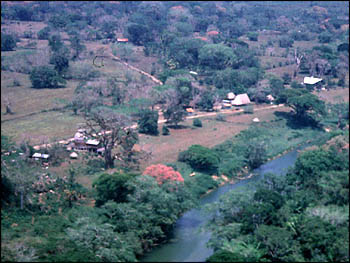
The
maps should be useful by themselves for warning the government of
potential malaria outbreaks in newly-settled areas. Ultimately, the scientists
would like to combine this mapping system with the database of houses at risk.
"We would match the map up with the national malaria database to determine how
many malaria cases occurred over the last ten years. We would bring all of those
elements of data together to begin targeting houses for spray," Roberts said.
The final product would resemble the slide of the Belizian village Roberts
displayed in his lab, except the homes identified within the database
would be accompanied by highlighted areas where the mosquitoes live. Not only
would the government spray the highly infectious houses, but those closest to
mosquitoes’ breeding habitats as well.
Within five years the scientists will have everything in place and begin field
testing the model on individual villages. From what he's seen so far, Roberts is
confident this method would work on a nationwide scale. By spraying roughly 3,600
houses, Belize could both reduce a majority of its malaria problem and amount of
labor and insecticide used. The Belizian model
could also be used as a blueprint for other countries in Central America, Asia
and Africa. These nations would still have to determine the habitats of the
mosquito species in their part of the world and build a database, but with
Roberts's study as a model, they would know what to do to and how to make it work
without much waste.
Roberts’ biggest worry now, however, isn't that his system will be
useful. His biggest fear is programs underway by the United States and other
wealthy nations to ban the use of DDT around the world. Roberts argued that there
have been many studies comparing chemical irritants and repellents, and DDT is
the only one that is known to repel mosquitoes throughout the evening. It is also
the only one that most small governments can afford to buy in bulk.
References:
1. World Health Organization, 1999: Leading Infectious Killers, Removing
Obstacles to Healthy Development.
2. World Health Organization, Division of Control of Tropical Diseases, 1998:
Malaria Prevention and Control. (http://www.who.int/ctd/html/)
3. The Malaria Network, 1998: Fact Sheet 95. (http://www.malarianetwork.org/)
4. Shell, Ellen Ruppel, 1997: Resurgence of a Deadly Disease, The Atlantic
Monthly. August, 1997, pp. 45-60
5. Rejmankova, E., K. O. Pope, D. R. Roberts, M. G. Lege, R. Andre, J. Greico,
and Y. Alonzo, 1998: Characterization and Detection of Anopheles vestitipennis
and Anopheles puntimacula Larval Habitats in Belize with Field Survey and SPOT
Satellite Imagery, Journal of Vector Ecology, 23 (1) 1998, pp. 74-88.
6. Montgomery, Brian C., J. Grieco, P. M. Masuoka, D. Roberts, E. Rejmankova,
Y. Alonzo, R. Andre, H. Lenares, N. Achee, K. Pope, and S. Franklin, 1998: A
Remote Sensing Analysis of Vector Abundance and Malaria Riskk Associated with
Selected Villages in Southern Belize, C.A..
7. Roberts, D. R., J. F. Paris, S. Manquin, R. E. Harbach, R. Woodruff, E.
Rejmankova, J. Polanco, B. Wullschleger, and L. J. Legters, 1996: Predictions of
Malaria Vector Distribution in Belize Based on Multispectral Satellite Data,
American Journal of Tropical Medicine and Hygiene, 54(3), 1996. pp.
304-308.
 Spotting Infection Spotting Infection
|
|
Larvae of Anopheles darlingi (another important vector of malaria in
Belize) are found in river habitats. Villages and individual houses are
commonly associated with rivers, as depicted in this aerial view of the
Sibun River. (Photograph courtesy Dr. Donald Roberts, Uniformed Health Services) |

